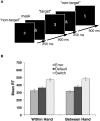Intended actions and unexpected outcomes: automatic and controlled processing in a rapid motor task
- PMID: 22912612
- PMCID: PMC3419874
- DOI: 10.3389/fnhum.2012.00237
Intended actions and unexpected outcomes: automatic and controlled processing in a rapid motor task
Abstract
Human action involves a combination of controlled and automatic behavior. These processes may interact in tasks requiring rapid response selection or inhibition, where temporal constraints preclude timely intervention by conscious, controlled processes over automatized prepotent responses. Such contexts tend to produce frequent errors, but also rapidly executed correct responses, both of which may sometimes be perceived as surprising, unintended, or "automatic". In order to identify neural processes underlying these two aspects of cognitive control, we measured neuromagnetic brain activity in 12 right-handed subjects during manual responses to rapidly presented digits, with an infrequent target digit that required switching response hand (bimanual task) or response finger (unimanual task). Automaticity of responding was evidenced by response speeding (shorter response times) prior to both failed and fast correct switches. Consistent with this automaticity interpretation of fast correct switches, we observed bilateral motor preparation, as indexed by suppression of beta band (15-30 Hz) oscillations in motor cortex, prior to processing of the switch cue in the bimanual task. In contrast, right frontal theta activity (4-8 Hz) accompanying correct switch responses began after cue onset, suggesting that it reflected controlled inhibition of the default response. Further, this activity was reduced on fast correct switch trials suggesting a more automatic mode of inhibitory control. We also observed post-movement (event-related negativity) ERN-like responses and theta band increases in medial and anterior frontal regions that were significantly larger on error trials, and may reflect a combination of error and delayed inhibitory signals. We conclude that both automatic and controlled processes are engaged in parallel during rapid motor tasks, and that the relative strength and timing of these processes may underlie both optimal task performance and subjective experiences of automaticity or control.
Keywords: ERN; MEG; automaticity; beta oscillations; frontal theta; motor cortex; response inhibition; response switching.
Figures







Similar articles
-
Complementary roles of cortical oscillations in automatic and controlled processing during rapid serial tasks.Neuroimage. 2015 Sep;118:268-81. doi: 10.1016/j.neuroimage.2015.05.081. Epub 2015 Jun 3. Neuroimage. 2015. PMID: 26049145
-
Inhibitory Control in the Absence of Awareness: Interactions Between Frontal and Motor Cortex Oscillations Mediate Implicitly Learned Responses.Front Hum Neurosci. 2021 Dec 22;15:786035. doi: 10.3389/fnhum.2021.786035. eCollection 2021. Front Hum Neurosci. 2021. PMID: 35002659 Free PMC article.
-
Cortical Oscillatory Mechanisms Supporting the Control of Human Social-Emotional Actions.J Neurosci. 2018 Jun 20;38(25):5739-5749. doi: 10.1523/JNEUROSCI.3382-17.2018. Epub 2018 May 23. J Neurosci. 2018. PMID: 29793973 Free PMC article.
-
When the brain changes its mind: Oscillatory dynamics of conflict processing and response switching in a flanker task during alcohol challenge.PLoS One. 2018 Jan 12;13(1):e0191200. doi: 10.1371/journal.pone.0191200. eCollection 2018. PLoS One. 2018. PMID: 29329355 Free PMC article.
-
[The role of inhibition in obsessional-compulsive disorders].Encephale. 2013 Feb;39(1):44-50. doi: 10.1016/j.encep.2012.06.016. Epub 2012 Sep 23. Encephale. 2013. PMID: 23095598 Review. French.
Cited by
-
Decreased event-related theta power and phase-synchrony in young binge drinkers during target detection: An anatomically-constrained MEG approach.J Psychopharmacol. 2019 Mar;33(3):335-346. doi: 10.1177/0269881118805498. Epub 2018 Oct 24. J Psychopharmacol. 2019. PMID: 30355025 Free PMC article.
-
Neural indices of heritable impulsivity: Impact of the COMT Val158Met polymorphism on frontal beta power during early motor preparation.Biol Psychol. 2024 Sep;191:108826. doi: 10.1016/j.biopsycho.2024.108826. Epub 2024 Jun 9. Biol Psychol. 2024. PMID: 38862067 Free PMC article.
-
Cortical Oscillatory Activity and Motor Control in Pediatric Stroke Patients With Hemidystonia.Hum Brain Mapp. 2025 Apr 1;46(5):e70204. doi: 10.1002/hbm.70204. Hum Brain Mapp. 2025. PMID: 40186512 Free PMC article.
-
Defining the Parameters of Incidental Learning on a Serial Reaction Time (SRT) Task: Do Conscious Rules Apply?Brain Sci. 2012 Dec 17;2(4):769-89. doi: 10.3390/brainsci2040769. Brain Sci. 2012. PMID: 24961269 Free PMC article.
-
Distinct α- and β-band rhythms over rat somatosensory cortex with similar properties as in humans.J Neurophysiol. 2016 Jun 1;115(6):3030-44. doi: 10.1152/jn.00507.2015. Epub 2016 Mar 23. J Neurophysiol. 2016. PMID: 27009160 Free PMC article.
References
LinkOut - more resources
Full Text Sources

